Controlling the spectral persistence of a random laser
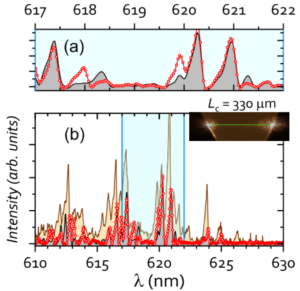
Random lasers represent a relatively undemanding technology for generating laser radiation that displays unique characteristics of interest in sensing and imaging. Furthermore, they combine the classical laser’s nonlinear response with a naturally occurring multimode character and easy fabrication, explaining why they have been recently proposed as ideal elements for complex networks. The typical configuration of a random laser consists of a disordered distribution ofscattering centers spatially mixed into the gain medium. When optically pumped, these devices exhibit spectral fluctuations from pulse to pulse or constant spectra, depending on the pumping conditions and sample properties. Here, we show clear experimental evidence of the transition from fluctuating (uncorrelated) to persistent random laser spectra, in devices in which the gain material is spatially separated from the scattering centers. We interpret these two regimes of operation in terms of the number of cavity round trips fitting in the pulse duration. Only if the cavity round-trip time is much smaller than the pulse duration are modes allowed to interact, compete for gain, and build a persisting spectrum. Surprisingly this persistence is achieved if the pumping pulse is long enough for radiation in the cavity to perform some 10 round trips. Coupled-mode theory simulations support the hypothesis. These results suggest an easy yet robust way to control mode stability in random lasers and open the pathway for miniaturized systems, as, for example, signal processing in complex random laser networks.
Artificial intelligence and advanced materials
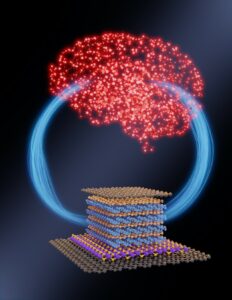 Artificial intelligence (AI) is gaining strength, and materials science can both contribute to and profit from it. In a simultaneous progress race, new materials, systems, and processes can be devised and optimized thanks to machine learning (ML) techniques, and such progress can be turned into innovative computing platforms. Future materials scientists will profit from understanding how ML can boost the conception of advanced materials. This review covers aspects of computation from the fundamentals to directions taken and repercussions produced by computation to account for the origins, procedures, and applications of AI. ML and its methods are reviewed to provide basic knowledge of its implementation and its potential. The materials and systems used to implement AI with electric charges are finding serious competition from other information‐carrying and processing agents. The impact these techniques have on the inception of new advanced materials is so deep that a new paradigm is developing where implicit knowledge is being mined to conceive materials and systems for functions instead of finding applications to found materials. How far this trend can be carried is hard to fathom, as exemplified by the power to discover unheard of materials or physical laws buried in data.
Artificial intelligence (AI) is gaining strength, and materials science can both contribute to and profit from it. In a simultaneous progress race, new materials, systems, and processes can be devised and optimized thanks to machine learning (ML) techniques, and such progress can be turned into innovative computing platforms. Future materials scientists will profit from understanding how ML can boost the conception of advanced materials. This review covers aspects of computation from the fundamentals to directions taken and repercussions produced by computation to account for the origins, procedures, and applications of AI. ML and its methods are reviewed to provide basic knowledge of its implementation and its potential. The materials and systems used to implement AI with electric charges are finding serious competition from other information‐carrying and processing agents. The impact these techniques have on the inception of new advanced materials is so deep that a new paradigm is developing where implicit knowledge is being mined to conceive materials and systems for functions instead of finding applications to found materials. How far this trend can be carried is hard to fathom, as exemplified by the power to discover unheard of materials or physical laws buried in data.
Hypersonic phonon transport
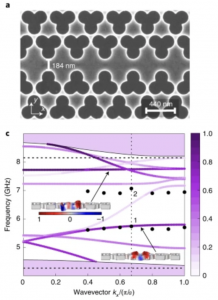 Controlling vibrations in solids is crucial to tailor their elastic properties and interaction with light. Thermal vibrations represent a source of noise and dephasing for many physical processes at the quantum level. One strategy to avoid these vibrations is to structure a solid such that it possesses a phononic stop band, that is, a frequency range over which there are no available elastic waves. Here we demonstrate the complete absence of thermal vibrations in a nanostructured silicon membrane at room temperature over a broad spectral window, with a 5.3-GHz-wide bandgap centred at 8.4 GHz. By constructing a line-defect waveguide, we directly measure gigahertz guided modes without any external excitation using Brillouin light scattering spectroscopy. Our experimental results show that the shamrock crystal geometry can be used as an efficient platform for phonon manipulation with possible applications in optomechanics and signal processing transduction.
Controlling vibrations in solids is crucial to tailor their elastic properties and interaction with light. Thermal vibrations represent a source of noise and dephasing for many physical processes at the quantum level. One strategy to avoid these vibrations is to structure a solid such that it possesses a phononic stop band, that is, a frequency range over which there are no available elastic waves. Here we demonstrate the complete absence of thermal vibrations in a nanostructured silicon membrane at room temperature over a broad spectral window, with a 5.3-GHz-wide bandgap centred at 8.4 GHz. By constructing a line-defect waveguide, we directly measure gigahertz guided modes without any external excitation using Brillouin light scattering spectroscopy. Our experimental results show that the shamrock crystal geometry can be used as an efficient platform for phonon manipulation with possible applications in optomechanics and signal processing transduction.
Colloidal crystals formation
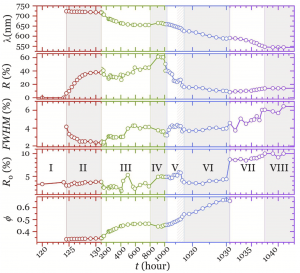 Colloidal suspensions crystallize by a natural sedimentation process under certain conditions, the initial volume fraction being one of the parameters that govern this process. Here, we have developed a simple in-situ, real-time, optical characterization technique to study silica colloidal suspensions during natural sedimentation in order to shed new light on this crystallization process. This technique monitors small variations in the wavelength of the reflectance features, allowing the analysis of the formation of the first layers of the crystal with sub-nanometer precision, and their dynamics, which is crucial to ensure a high quality in the final sample. The experimental results indicate that, in certain range of volume fraction, spontaneous crystallization of a colloidal fluid occurs at the bottom of the suspension, as a phase change, then through evaporation of the water it compacts to near close-packed and, eventually, dries. Understanding self-assembly at these scales is paramount in materials science and our results will contribute to improve and characterize the quality and crystallinity of the materials used in this process.
Colloidal suspensions crystallize by a natural sedimentation process under certain conditions, the initial volume fraction being one of the parameters that govern this process. Here, we have developed a simple in-situ, real-time, optical characterization technique to study silica colloidal suspensions during natural sedimentation in order to shed new light on this crystallization process. This technique monitors small variations in the wavelength of the reflectance features, allowing the analysis of the formation of the first layers of the crystal with sub-nanometer precision, and their dynamics, which is crucial to ensure a high quality in the final sample. The experimental results indicate that, in certain range of volume fraction, spontaneous crystallization of a colloidal fluid occurs at the bottom of the suspension, as a phase change, then through evaporation of the water it compacts to near close-packed and, eventually, dries. Understanding self-assembly at these scales is paramount in materials science and our results will contribute to improve and characterize the quality and crystallinity of the materials used in this process.
Electrically driven random lasers
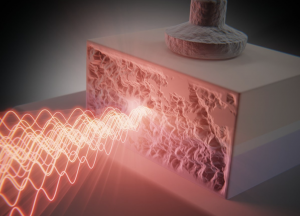 Random lasers are intriguing devices with promising applications as light sources for imaging, sensing, super-resolution spectral analysis or complex networks engineering. Random lasers can be obtained from optically pumped dyes, optical fibres and crystals or electrically pumped semiconductor heterostructures. Semiconductor random lasers are usually fabricated by introducing scattering defects into the active layer, adding a degree of complexity to the fabrication process and losing the ease of realization potentially offered by disordered structures. The ready availability of electrically pumped random lasers, avoiding a costly fabrication approach, would boost the use of these devices in research and applications. Here we realize an incoherent semiconductor random laser by simply processing the output mirror of an off-the-shelf Fabry–Pérot laser diode via controlled laser ablation. Optical feedback provided by the intact back mirror and the ablated front mirror results in multimode random lasing with low spatial coherence and disordered angular patterns. This result constitutes a proof of principle for future ground-breaking technology developments in the field of random lasers.
Random lasers are intriguing devices with promising applications as light sources for imaging, sensing, super-resolution spectral analysis or complex networks engineering. Random lasers can be obtained from optically pumped dyes, optical fibres and crystals or electrically pumped semiconductor heterostructures. Semiconductor random lasers are usually fabricated by introducing scattering defects into the active layer, adding a degree of complexity to the fabrication process and losing the ease of realization potentially offered by disordered structures. The ready availability of electrically pumped random lasers, avoiding a costly fabrication approach, would boost the use of these devices in research and applications. Here we realize an incoherent semiconductor random laser by simply processing the output mirror of an off-the-shelf Fabry–Pérot laser diode via controlled laser ablation. Optical feedback provided by the intact back mirror and the ablated front mirror results in multimode random lasing with low spatial coherence and disordered angular patterns. This result constitutes a proof of principle for future ground-breaking technology developments in the field of random lasers.